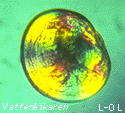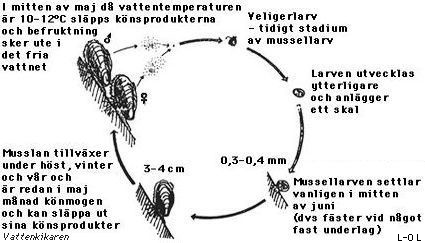|

Way
of life
|
|
Reproduction

Blue mussel larva
approx. 0,2-0,3 mm in diameter.
During the spring, when water temperatures rise to about 10-12 °C
the Blue mussel begins to mate. Mussels have different sexes, and the
male is the first release its MILK into the water. This is sensed by the
females by immediately releasing their eggs into the water. A female of
average size can release between 5-12 million eggs into the water, where
they in 24 hours transform into
larvae with a shell, sail and a characteristic black eye. They live
in a suspended stage for about 3-4 weeks, whereupon they start the second
stage of their life - the attached stage. The mussel starts looking for
a suitable foundation to attach itself to. The larvae examines the different
surfaces it meets and when it finds a suitable surface, it attaches itself
with a few byssus threads. This method of anchoring is secreted from a
byssus gland and is used the whole of its life span. The more the mussel
is exposed to waves
and currents, the more byssus threads it developes. If the mussel should
need to move, it cuts off its threads and developes new later.

|

|
Page
3 of 4
|

|
|